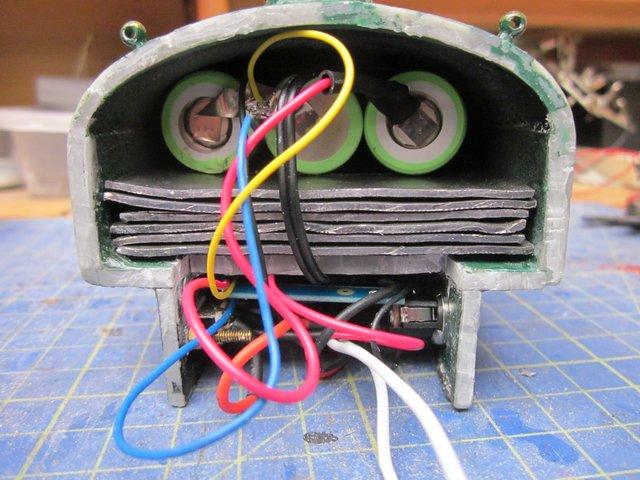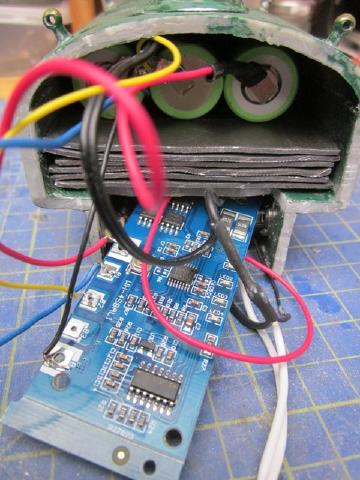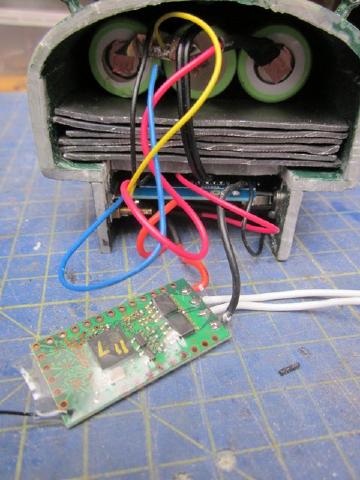Page 1 of 1
GRS Hunslet battery conversion
Posted: Tue Jul 14, 2015 4:06 pm
by ge_rik
I realise I'm a bit of an oddity on the forum as all my operational locos are battery powered, including those which are steam outline. Mind you, I'm also an oddity on the G Scale forum as I've now abandoned track power, and all my stock is UK based. However, I am perfectly happy ploughing my own furrow as battery power suits the way I operate my railway.
I just thought I'd share with you how I've gone about my latest conversion from track power to battery in case it's of interest.
I constructed a Hunslet-style loco a few years ago from a GRS kit on an LGB Toytrain 0-4-0 motor block. Since I went over fully to battery power, she has been languishing on a shelf. I was worried I might irreparably damage her resin castings when taking her apart to create space for the batteries and electronics. As it turned out, some gentle prising with a flat bladed screwdriver was all that was needed. However, I felt her paintwork needed rubbing down as it had suffered in the process:

After removing the lead 2kg of lead weights from the saddle tank, I found there was room for three 3.7v 3000mAh 18650 li-ion batteries and some lead. These batteries have solder tags.

As the batteries were 'unprotected', I installed a battery protection board, which monitors balance charging and protects against over discharge, short circuit and over-heating.

You've probably heard the horror stories about lithium batteries exploding and catching fire. There is some risk associated with using them, but provided they are electronically protected, charged carefully and not abused, I feel the benefits of using them outweigh the risks.
A Deltang Rx65b combined receiver/ESC was then wired in. Both the protection board and the rx fit into the lower half of the boiler.

The charge socket is a bit prominent just below the saddle tank, but there really was nowhere else to put it.

I've given her some test runs and she seems to perform well. She's urgently in need of a repaint - I'll post some more pics and maybe a video when she fully enters service.
It's great to have a Hunslet (ish) loco back on the line. Doesn't feel right running a ng light railway without one, somehow.
Rik
Posted: Tue Jul 14, 2015 4:36 pm
by Gralyn
Nice to see the conversion Rik, where did you get the LiIon batteries with the tags on from?.
Re: GRS Hunslet battery conversion
Posted: Tue Jul 14, 2015 5:55 pm
by andymctractor
ge_rik:112044 wrote:I realise I'm a bit of an oddity on the forum as all my operational locos are battery powered, including those which are steam outline.
I think 'oddity' is a bit unfair. Everyone in this garden railway hobby is a little bit odd in one way or another. I for one prefer battery powered locos to live steam for normal operation even though my railway is a continuous run. I have two live steamers that I use when I'm in the mood and get great fun from them but I've certainly looked very closely at the idea of battery powered steam outline.
Posted: Tue Jul 14, 2015 5:57 pm
by Peter Butler
Perfectly timed thread this as I have some track powered locos to alter too! I have no knowledge of the items you have used so I am watching and learning.
Posted: Tue Jul 14, 2015 7:24 pm
by philipy
Peter,
Following some of Rik's previous writeups/blogs, I've used Deltang rx/tx in one of mine, so far, and I'm very impressed. I think I have a long term plan to convert/upgrade all of my rc to Deltang since one Tx can control up to 12 Rx's simly by turning a knob.
Posted: Tue Jul 14, 2015 8:08 pm
by ge_rik
Gralyn:112045 wrote:Nice to see the conversion Rik, where did you get the LiIon batteries with the tags on from?.
Hi Graham
I get mine through an eBay shop called Ecolux. There are probably cheaper sources but they seem to stock only branded batteries and the do test and guarantee the ratings on the batteries they sell.
These are the ones I buy
http://www.ebay.co.uk/itm/360970411157
I would urge you to get protection circuitry for them though. Li-ions are irreparably damaged if they are over-discharged. I've just invested in some smaller, cheaper protection boards from China
http://www.ebay.co.uk/itm/181777152056
I've no idea what they're like as I've only just ordered them
Rik
Posted: Tue Jul 14, 2015 8:20 pm
by ge_rik
Andy / Peter
I wish you well. I certainly have no regrets with my move to battery power.
I did a fair bit of background reading on the various technologies before I took the plunge - and I'm still learning. I know in the Large Scale Trains fraternity there are some who are very anti lithium batteries in any form. But if you consider that a lot of technology is now powered by li-ion - phones, drills, laptops, this tablet - then provided you take care, then the benefits outweigh the risks. But, if you have any doubts or concerns then play safe with NiMh rechargeables.
Rik
Posted: Tue Jul 14, 2015 8:25 pm
by ge_rik
philipy:112049 wrote:Peter,
Following some of Rik's previous writeups/blogs, I've used Deltang rx/tx in one of mine, so far, and I'm very impressed. I think I have a long term plan to convert/upgrade all of my rc to Deltang since one Tx can control up to 12 Rx's simly by turning a knob.
Philip
I echo that wholeheartedly. Not only is Deltang stuff very clever, it's very small, well engineered and a lot cheaper than many of the alternatives. At present, though, it's limited to a max of 3A and 18v but that's more than enough for my little locos. Even then, they can haul a lot more than I would realistically need on my railway.
Rik
Posted: Wed Jul 15, 2015 6:35 am
by philipy
My only citicism is his instructions which I found vague in places, to say the least. I have yet to venture into programming it ( which I know you have done successfully, I've seen your blog video) simply because I can't get my head around his paperwork on the subject!
Posted: Wed Jul 15, 2015 7:06 am
by ge_rik
philipy:112053 wrote:My only citicism is his instructions which I found vague in places, to say the least. I have yet to venture into programming it ( which I know you have done successfully, I've seen your blog video) simply because I can't get my head around his paperwork on the subject!
I agree. Some of his guidance is a bit too techie - it assumes a fair bit of specialist knowledge. However, even I evetually managed to get to the point where I can now reprogram the receivers. Mind you, he keeps innovating, so no sooner do you get to know one thing than he supercedes it with more.
I have got another blog page in preparation which gives a more accessible intro to his kit, however, just when I think I've completed it he brings out another version of his receivers so I have to update it. I must try to publish it soon, as it sounds like it might be useful.
Rik
Posted: Wed Jul 15, 2015 7:38 am
by Alan P
My line is mainly steam however I do run a few battery locos and I use lithium polymer batteries in all but one of them.
LiPos last for ages on a single charge, they also have the added bonus of not discharging when not in use.
If space is at a premium you can get some really small ones. You do need to use a decent balanced charger with them though.
My one exception to LiPos is my very old Friog Diesel which still has it's original NiCads.
Even though they are about 20 years old now they still work remarkably well.
Re: GRS Hunslet battery conversion
Posted: Wed Jul 15, 2015 9:16 am
by GTB
ge_rik:112044 wrote:
I just thought I'd share with you how I've gone about my latest conversion from track power to battery in case it's of interest.
Always of interest.......

The RCS hardware I use is also Deltang based, but Tony wrote his own manuals and wiring diagrams, which are a bit easier to follow I found.
I'd probably make up a tool box to disguise the charging socket with a dummy plug on the back to keep it in place.
Regards,
Graeme
Posted: Thu Jul 16, 2015 9:03 am
by ge_rik
Alan P:112055 wrote:My line is mainly steam however I do run a few battery locos and I use lithium polymer batteries in all but one of them.
LiPos last for ages on a single charge, they also have the added bonus of not discharging when not in use.
If space is at a premium you can get some really small ones. You do need to use a decent balanced charger with them though.
My one exception to LiPos is my very old Friog Diesel which still has it's original NiCads.
Even though they are about 20 years old now they still work remarkably well.
All but one of my locos have li-ion of one sort or another. Like you I like their high capacity for small volume and their self-discharge rates are relatively low at about 10-20% per month.
The one non li-ion is powered by LSD (low self discharge) NiMh batteries which are better that normal NiMhs at holding their charge. There's nothing more frustrating than wanting to use a loco and finding it'batteries have flattened.
Rik
Re: GRS Hunslet battery conversion
Posted: Thu Jul 16, 2015 6:37 pm
by ge_rik
GTB:112059 wrote:ge_rik:112044 wrote:
I just thought I'd share with you how I've gone about my latest conversion from track power to battery in case it's of interest.
Always of interest....... ;)
The RCS hardware I use is also Deltang based, but Tony wrote his own manuals and wiring diagrams, which are a bit easier to follow I found.
I'd probably make up a tool box to disguise the charging socket with a dummy plug on the back to keep it in place.
Regards,
Graeme
Yes, Tony's manuals are a lot more explicit than David's. I don't think Tony is that hot on programming, though. On the few occasions when I got a bit stuck, I emailed David and he got back to me with very helpful advice (peppered with the occasional techie references).
Rik
Posted: Thu Jul 16, 2015 9:11 pm
by big-ted
Nice little model. Looks like you could have squeezed another two cells in that saddle tank had you tried hard enough though!
Just to chime in on the battery issue, as it's an area in which I have some experience. There is a fundamental difference between lithium-ion, and lithium-polymer batteries. Li-ion are used in cellphones and laptops, as they have excellent lifetimes and are very robust to charge-discharge cycles. Li-pos tend to be used in high current applications as they can discharge very quickly without damage to the cell.
Operationally, there is very little to worry about with Li-ion cells. The fire concerns apply only to Li-pos as they have very little internal resistance. This means that, should a short occur, the battery will happily provide extremely large numbers of amps, potentially melting wring and causing fires. In contrast, other battery technologies have more significant internal resistances, which limit the current that can flow even when the external resistance is zero (short circuit). Whilst sparks and damage can occur, it tends to be rather less catastrophic in these cases.
That said, Li-Pos can be used very safely without cause for concern. I taught a robotics lab in which I had ~40 students working with Li-Po batteries and, whilst we always had fire extinguishers and sand buckets to hand, we never had any problems in 3 years of my running the course. Just exercise due diligence is all.
Posted: Fri Jul 17, 2015 8:50 am
by ge_rik
big-ted:112078 wrote:Nice little model. Looks like you could have squeezed another two cells in that saddle tank had you tried hard enough though!
Just to chime in on the battery issue, as it's an area in which I have some experience. There is a fundamental difference between lithium-ion, and lithium-polymer batteries. Li-ion are used in cellphones and laptops, as they have excellent lifetimes and are very robust to charge-discharge cycles. Li-pos tend to be used in high current applications as they can discharge very quickly without damage to the cell.
Operationally, there is very little to worry about with Li-ion cells. The fire concerns apply only to Li-pos as they have very little internal resistance. This means that, should a short occur, the battery will happily provide extremely large numbers of amps, potentially melting wring and causing fires. In contrast, other battery technologies have more significant internal resistances, which limit the current that can flow even when the external resistance is zero (short circuit). Whilst sparks and damage can occur, it tends to be rather less catastrophic in these cases.
That said, Li-Pos can be used very safely without cause for concern. I taught a robotics lab in which I had ~40 students working with Li-Po batteries and, whilst we always had fire extinguishers and sand buckets to hand, we never had any problems in 3 years of my running the course. Just exercise due diligence is all.
Thanks, that's very reassuring.
I had a suspicion that li-ion were inherently more stable and less volatile than lipo, but there does seem to be a general anxiety in some quarters about any type of lithium battery - not helped of course by the ban on sending them through the post.
Rik




